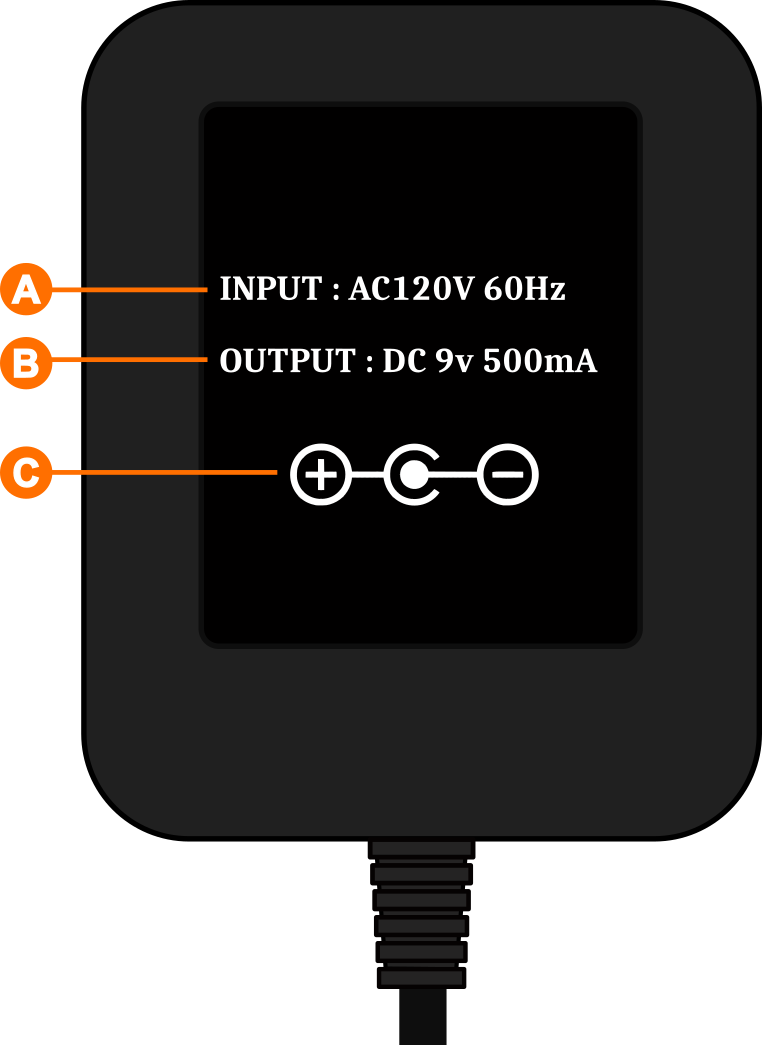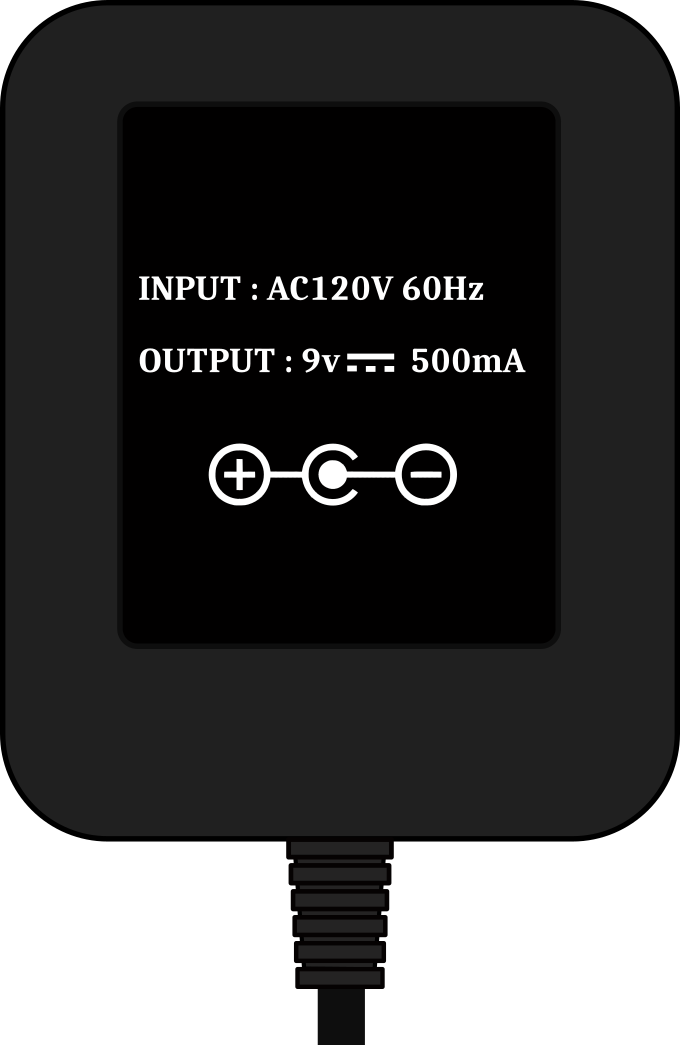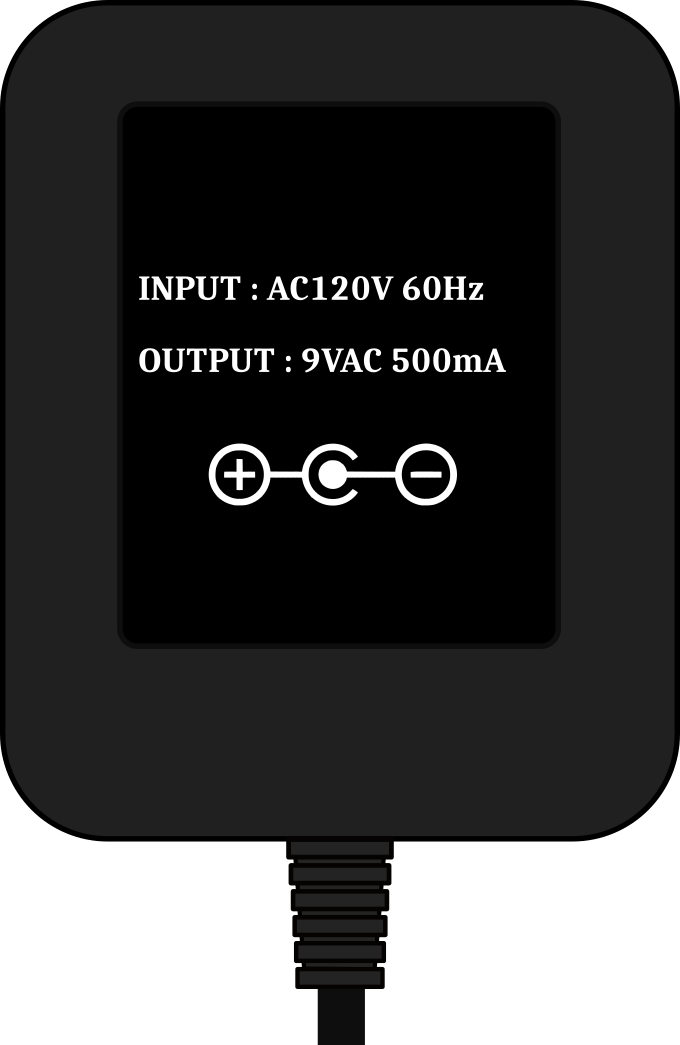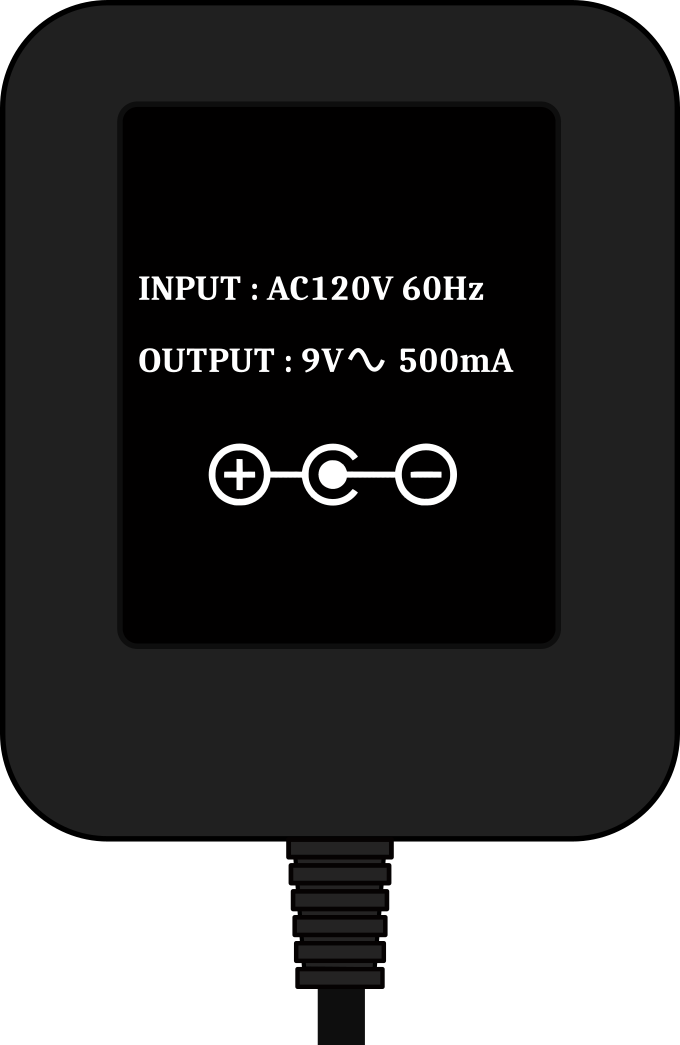Understanding Power Supplies
This is a work in progress.....
Power Supplies: Understanding them and which ones to use
The typical guitar pedal uses a 9 volt, DC, center negative power supply. Well, what does that mean and how do I know what I'm buying or using?
We are going to talk about single wall power supply. AKA a wallwart. Most power supplies have the input voltage, output voltage, and polarity printed on it. They come in DC and AC voltage. There is a big difference between 9v DC and 9v AC. If you plug a AC power supply into a DC pedal, most likely you are going to fry it. No matter how long you had it in there, it starts frying things instantly.
Below we're going to take a look at both a AC and a DC power supply and learn how to tell what everything on it is telling you.
Let's start with a typical DC power supply and the power supply image below on the left.
A - This is the input voltage. Meaning the voltage that is coming out of the wall socket. You want this to match your countries power. You wouldn't want to use this power supply in a 220v outlet. You will need some sort of of voltage converter. This parts pretty easy not to mess up as the prongs you plug into the wall are usually voltage specific.
B - This is the output voltage. Meaning the voltage the power supply outputs. This is super important. This power supply is saying it outputs 9v and it's DC. 500mA is the amperage rating. This is how much amperage it can supply. These three things (DC, 9v, and 500mA) are very important. You will want to look at your pedal and/or it's manual to see what power supply it needs. You may also see a power supply that says something like 1A or 2A instead of mA. The A stands for amp (or ampere). A mA is one one-thousandth of an amp.
C - This is the polarity symbol. This shows you what polarity the plug at the end of the power supply cord has. You want to match this with what your pedal requires. You don't want to have it reversed or you can do some damage. This particular symbol shows the center of the plug is negative (shown by the negative sign on the right pointing to the center dot) and the outer of the plug is positive (shown by the + pointing to the outer semicircle which is very common for pedals.
The power supply on the right is exactly the same as on the left. In this case they show a symbol (A line with 3 dashes below it) which represents DC. Both of these output 9vDC and 500mA.
 |
 |
Now let's take a look at an AC power supply. Again we'll start with the image on the left. It has all the same information as the DC jack does except the output voltage is different. In this case it's AC voltage instead of DC. This image on the right also has AC output and just like the DC jack supply it shows a symbol for AC (the wavy line) instead of writing AC.
 |
 |
Common DC Jacks
Here are some common DC jacks used in pedals and their connections:
Below is a switched DC jack. Meaning when a DC cable is inserted into it, it disconnects the "Switched Outer" lug. This is useful for us to hook a battery up to the pedal. The battery + is typically hooked up to the Switched Outer lug so when a DC cable is inserted, it disconnects the battery so you aren't running the pedal on both the DC adapter and the battery. When the DC cable is removed, the battery is reconnected.

Pro Tip:
To prevent accidentally plugging in the wrong power supply and potential damage to the pedal, get some bright colored heat shrink tubing and put it on the end of the power cable you plug into your pedal. Put the tubing on any cable end that isn't the standard 9vDC center negative. You can use different colors for different voltages if you have multiple voltages/polarities. Example: Yellow for 12v, blue for 18v, red for center positive, etc. You can even write what they are on them. It's easy to remove also if you change things around.
How do I know what power supply the pedal I'm using needs?
Some of the time the pedal will tell you right on it. It will say something like "9VDC" and it also probably shows the polarity symbol on it. Another good source is to look at the manual. The manual usually tells you what power supply to use. Some manufacturers say to only use their power supply. In some cases this is important if they have a specific plug or have some special filtering/circuitry in the power supply but in most cases, as long as the power supply you use matches the pedals requirements, you can use any power supply. Now I will recommend using power supplies that are actually made for pedals. Not a generic power supply. Generic power supplies may work in most cases but they can introduce noise and can even make pedals act weird.
What is mA and what does it have to do with my pedal?
A milliamp (mA) is a unit used to measure electrical current and is equal to one one-thousandth of an ampere (A). You'll want to look at your power supply to see how many milliamps or amps it outputs. We are now going to be dealing with the pedals current draw. Lets use the illustrations of the power supplies above as an example. They output 500mA. You will want to look at the manual for your pedal and make sure the current draw of that pedal is below 500mA. It is OK to use a power supply that has more amperage than the pedal uses. For example, if the manual says a pedal has a current draw of 30mA. It is perfectly fine to use this 500mA power supply. The pedal will only draw what current it needs. If you use a supply that doesn't provide enough amperage then it won't work. However, t is NOT good to use a power supply that has more voltage. It can fry your pedal.
What can I do so I don't mix up and accidentally plug 18 or 12 volts into a 9v pedal?
This is certainly something you don't want to do. Using a higher voltage power supply can fry your pedal. What I've done is use heat shrink tubing to color code my plug ends. I'll use red for any AC plugs and yellow for 18v and blue for 12v. You can also just use yellow or some other light color and write "12V" or "AC" or "12VAC" on it with black marker. Just make them stand out.
Can I use 12 or 18v on my pedal to get more headroom?
From time to time a get a pedal in for repair from someone who read on the internet that they could plug in a 12 or 18v power supply to their 9v pedal for more headroom. Problem here is over the years, companies can change their circuits a bit and/or they can use a component that has a lower rating than the previous production run. It's not safe to just assume it will work on your pedal just because it did on someone else's. You will be taking a chance that you may fry your pedal. If you want to run a pedal at a higher voltage, you need to go through every voltage sensitive component in there and make sure the voltage rating is higher than the voltage you are going to supply to the pedal.
Pedal/Company says, "Use only provided power supply" or only to use their power supply. Can I use a different power supply or a multi power supply?
Yes, you can use a power supply or multi power supply provided this power supply meets all the pedals requirements. It has to be the proper AC or DC voltage, supply enough mA's, be the correct polarity, and a connector that fits properly. A lot of manufacturers will say to only use their power supplies because they want to sell their power supply. Even if it comes with a power supply, it's good for them warranty-wise to say to just use their power supply.
Regulated vs Unregulated

